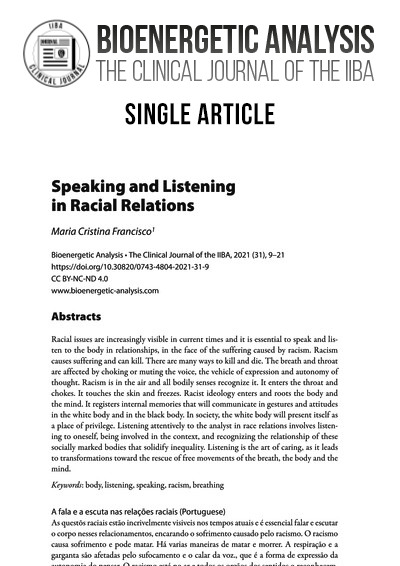Speaking and Listening in Racial Relations
##plugins.pubIds.doi.readerDisplayName##:
https://doi.org/10.30820/0743-4804-2021-31-9关键词:
body, listening, speaking, racism, breathing摘要
Racial issues are increasingly visible in current times and it is essential to speak and listen to the body in relationships, in the face of the suffering caused by racism. Racism causes suffering and can kill. There are many ways to kill and die. The breath and throat are affected by choking or muting the voice, the vehicle of expression and autonomy of thought. Racism is in the air and all bodily senses recognize it. It enters the throat and chokes. It touches the skin and freezes. Racist ideology enters and roots the body and the mind. It registers internal memories that will communicate in gestures and attitudes in the white body and in the black body. In society, the white body will present itself as a place of privilege. Listening attentively to the analyst in race relations involves listening to oneself, being involved in the context, and recognizing the relationship of these socially marked bodies that solidify inequality. Listening is the art of caring, as it leads to transformations toward the rescue of free movements of the breath, the body and the mind.
##submission.downloads##
已出版
2021-05-18
##submission.howToCite##
Francisco, M. C. (2021). Speaking and Listening in Racial Relations. Bioenergetic Analysis, 31(1), 9–21. https://doi.org/10.30820/0743-4804-2021-31-9
期
栏目
Articles
##submission.license##
##submission.copyrightStatement##
##submission.license.cc.by-nc-nd4.footer##This work is licensed under the Creative Commons Attribution-NonCommercial-NoDerivatives 4.0 International License (CC BY-NC-ND 4.0). This license allows private use and unmodified distribution, but prohibits editing and commercial use (further information can be found at: https://creativecommons.org/licenses/by-nc-nd/4.0/). The terms of the Creative Commons licence only apply to the original material. The reuse of material from other sources (marked with a reference) such as charts, illustrations, photos and text extracts may require further permission for use from the respective copyrights holder.


